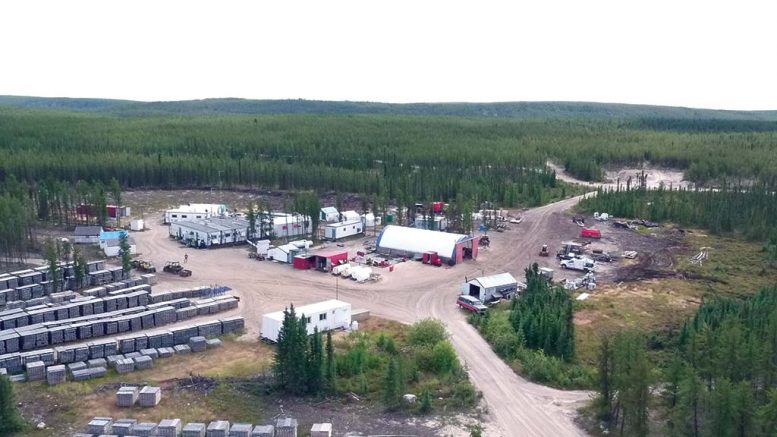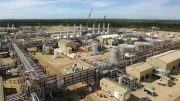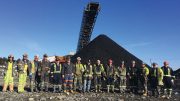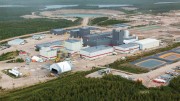In the last six months, Denison Mines (TSX: DML; NYSE-MKT: DNN) has reached a deal to increase its stake in the Wheeler River uranium project, raised $63.5 million in capital and released a series of drill results from its early 2017 drill program that not only confirm the high-grade nature of the project, but also underscore its potential to get bigger.
Wheeler River is the largest undeveloped, high-grade uranium project in the eastern part of the Athabasca basin region in northern Saskatchewan and consists of the Phoenix and Gryphon uranium deposits.
In January, Denison struck a deal with its joint-venture partners Cameco (TSX: CCO; NYSE: CCJ), which owns 30%, and JCU Exploration, which owns 10%, to increase its 60% stake up to 66%.
Under the agreement, Denison will fund 75% of the project’s expenses in 2017 and 2018 (ordinarily 60%), in exchange for its increased interest, while Cameco will fund 50% of its ordinary 30% share in 2017 and 2018. JCU will continue to fund its 10% interest.
In February, Denison closed a creative financing arrangement with the Anglo Pacific Group (TSX: APY; LON: APF) for $43.5 million, which will fund project development costs for Wheeler River to the completion of a bankable feasibility study and project financing.
The financing from Anglo Pacific, a diversified royalty company with a portfolio centered on base metals and bulk materials, monetizes Denison’s future share of toll-milling revenue at the McClean Lake mill from processing ore from the Cigar Lake mine. Under the arrangement, Denison keeps its 22.5% ownership of the McClean Lake joint venture, which includes several uranium deposits, and the McClean Lake mill.
The non-dilutive financing was followed in March by a private placement that generated $20 million for Denison to fund exploration at Wheeler River until the end of 2018. The financing consisted of 5.79 million common shares at 95¢ per share, 8.5 million flow-through shares at $1.12 per share and 4.10 million flow-through shares at $1.23 per share.
Exploration results from the early 2017 drill program, meanwhile — which was completed in April and totalled 14,700 metres in 26 holes — have exceeded expectations, the company says.
Drill hole 633D3 returned intercepts of 3.3% uranium oxide (U3O8) over 13.5 metres, 6.2% U3O8 over 2.5 metres and 1.3% U3O8 over 3 metres, within the D series of lenses. Hole 633D3 ranks as the best hole to date in the D series of lenses and the mineralized intervals were 26 metres down-dip of an 11-metre interval grading 5.3% U3O8 in drill hole 641. Drill hole 689 returned a 1-metre intercept grading 15.1% U3O8.
The D series of mineralized lenses are not included in the current resource estimate for the Gryphon deposit at Wheeler River. Gryphon has an inferred resource of 834,000 tonnes grading 2.3% U3O8 for 42 million lb. U3O8 at a cut-off grade of 0.2% U3O8. The resource occurs as a series of stacked lenses on various stratigraphic, fault-controlled planes within the basement rocks called the A, B and C series lenses.
Since the resource was completed, however, the D series of lenses has been discovered and partly delineated within 200 metres north and northwest, and the company has discovered more mineralization on the deposit’s A and B planes.
Exploration drilling since the beginning of 2016 has defined a mineralized zone made up of multiple lenses spanning more than 300 metres in strike length, which remains open. The company says the D series of lenses will add resources to Gryphon.
The early 2017 drill program also incorporated infill and delineation drilling to convert inferred resources into the indicated category. Highlights from the infill drill campaign include 6 metres of 7.3% U3O8 including 10.9% U3O8 over 4 metres in 567D2, a hole drilled into the A series mineralization; 5.1% U3O8 over 7 metres including 7.6% U3O8 over 4.5 metres in hole 567D1, also in the A lense; and 1.9% U3O8 over 6.6 metres including 3.4% U3O8 over 3 metres in the B series lense in drill hole 567D2.
Denison plans to drill another 18 infill holes in its mid-year program.
“We’re putting the ingredients together to be the next producer in the region,” Denison’s president and CEO David Cates says. “We are focused on delivering good results because in this market you need competitive economics in a development project, and we will have to spend cash. We’ve been successful financing the company in early 2017, so we’re ready to take on the task of being the next producer in Canada. What is not cooperating, for everyone, is the uranium price.”
The spot price for U3O8 is US$21.50 per pound.
Despite the market, Denison is financed through to project financing, and is in “great financial shape,” Cates says, “which gives us the latitude to not worry from day to day about the uranium spot price.”
“It gives us a lot of flexibility. If the uranium price rises even moderately we will be positioned to go straight to project financing with the cash we have.”
Denison discovered Gryphon in 2014 and Phoenix in 2008. Phoenix, the world’s highest-grade, undeveloped known uranium deposit, is an unconformity deposit 3 km southeast of Gryphon, with an indicated resource of 166,000 tonnes grading 19.1% U3O8 for 70.2 million contained lb. U3O8. The resource calculation uses a cut-off grade of 0.8% U3O8.
A preliminary economic assessment that considered the potential economic merit of codeveloping the Gryphon and Phoenix deposits as a single underground mining operation was completed in April 2016.
The PEA estimated first production by 2025. “That’s based on the permitting timelines in the region and typical construction timelines. So could it be seven instead of 10? Yes, somewhere in that range may be a bit of wiggle room. But we’ve messaged 2025 and we’d rather beat that timeline than overpromise.”
The company will update its resource estimate towards year-end with a focus on maximizing indicated pounds. It plans to feed the updated resource estimate into the prefeasibility study, with the view of having the final study ready in 2018.
“There isn’t a laundry list of projects in the eastern Athabasca in the pipeline that are ahead of us,” he says. “Wheeler is actually at the front of the line.”






Be the first to comment on "Denison off to great start in 2017 at Wheeler River"